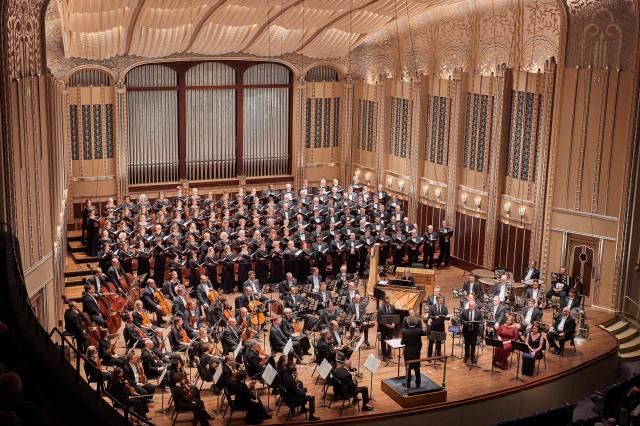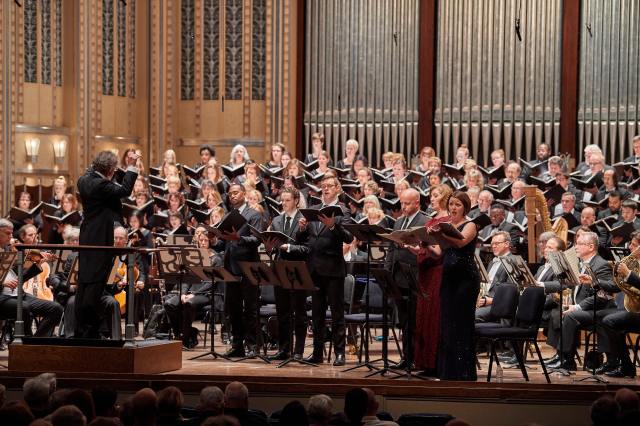Cleveland Orchestra
Franz Welser-Möst, conductor
Seraphic Fire
Patrick Dupré Quigley, artistic director
Margot Rood, soprano
Margaret Lias, mezzo-soprano
Steven Soph, tenor
Brian Giebler, tenor
James K. Bass, bass
Charles Wesley Evans, bass
Cleveland Orchestra Chorus
Robert Porco, director
Severance Hall
Cleveland, OH
March 18, 2017
Stravinsky: Feu d’artifice, Op. 4
Stravinsky: Apollo (1947 version)
Stravinsky: Symphonies of Wind Instruments (1947 version)
Stravinsky: Threni
An all-Stravinsky program that doesn’t include a note of The Firebird¸ Petrushka, or The Rite of Spring – impossible you say? Not for Franz Welser-Möst and the Cleveland Orchestra who presented a thoughtful survey of Stravinsky’s output while managing to skirt the well-worn blockbusters. Each of Stravinsky’s major stylistic periods were represented, and each work on the program was markedly different from the others, a testament to the composer’s remarkable versatility. A video of Welser-Möst speaking about the program can be viewed here:
Feu d’artifice, dating from 1908, comes from Stravinsky’s so-called Russian period that would eventually produce his watershed ballet scores for Diaghilev’s Ballets Russes. The brief but brilliant work is certainly the vision of a youthful firebrand, scored for large orchestra with some particularly striking writing for the celesta. While there was a sensuous contrasting theme, matters were largely big-boned and extrovert in this last vestige of Russian Romanticism.
Originally composed 1927-28, the ballet score Apollo (variously known by its French title Apollon musagète) was presented in its 1947 revision. Conceived for strings alone, Apollo is a major product of Stravinsky’s neoclassical period, both in terms of its language, elegant in its clarity and restraint, and its classical inspiration. The untroubled “Prologue” showcased the beauty of the Cleveland strings, and the ensuing “Variation d’Apollon” featured graceful solo playing from concertmaster William Preucil. A “Pas d’action” was characterized by long melodies well-suited to the strings which set up a series of variations depicting three of the Muses. The “Pas de deux” was delicate and given with an ineffable charm, while the “Coda” offered contrast in its jaunty syncopations. Matters were left in serenity by means of the concluding “Apothéose”, music of haunting stasis.
Apollo was suitably complemented by the Symphonies of Wind Instruments, also stemming from the neoclassical period, but earlier enough to offer some stylistic variety. Dating from 1919-20, like the preceding, it was performed in its revised version (coincidentally, from 1947 as well, also the year that the ever-fastidious composer revised Petrushka). The titular wind instruments were not restricted to just the woodwind family, but the broader category of aerophones; hence, the brass were included as well. “Symphonies”, in its intentional plurality, invoked the term’s Greek origins (literally, “sounding together”), and in the work Stravinsky accordingly was keen to explore various combinations of instrumentation.
Opening with striking, piquant harmonies, the work mercilessly jettisoned sentimentality, demanding such razor-sharp precision that its tempo changes were in a carefully proportioned 1:1.5:2 ratio. Under Welser-Möst’s taut direction, the desired effect was expertly achieved. A rhythmically-driven section recalled perhaps the primacy of rhythm in The Rite of Spring, and in spite of its apparent callousness, the work closed in a poignant chorale, meant as a tombeau for the recently deceased Debussy.

© Roger Mastroianni, courtesy of The Cleveland Orchestra
The evening’s most intriguing discovery was the final work, the rarely performed Threni, in its belated Cleveland premiere. Completed in 1958, it was the composer’s first completely serial foray, scored for full orchestra, chorus, and six vocal soloists. This weekend’s sextet of soloists were from the acclaimed South Florida based choral group Seraphic Fire. Subtitled “Lamentations of Jeremiah”, the 35-minute work sets text from the Old Testament in Vulgate Latin, punctuated by the chorus exclaiming a letter from the Hebrew alphabet which served as veritable signposts in this demanding score. Also useful in such unfamiliar territory were the detailed and informative remarks Welser-Möst presented prior to commencing.
The religious discipline was conveyed in the work’s austerity; despite being cast for large orchestra, the textures were dominated by sparse, chamber-like combinations. A brief introduction was given with declamatory seriousness by Margot Rood and Margaret Lias, soprano and mezzo-soprano respectively. The first section of the work proper (“De Elegia Prima”) was marked by very fine playing from Michael Sachs on the bugle (flugelhorn), often in dialogue with tenor Brian Giebler, and the chorus commanded a wide dynamic range, from monastic whispers to cataclysmic climaxes. “De Elegia Tertia” featured striking contributions from the booming bass of the aptly named James K. Bass, his delivery suggesting that of a monk. Stravinsky was almost certainly influenced by Gesualdo; the sophisticated pointillist counterpoint of a Renaissance motet was cleanly negotiated by all, and the closing “De Elegia Quinta” brought forth a conclusion of solemn resolution.

© Roger Mastroianni, courtesy of The Cleveland Orchestra
